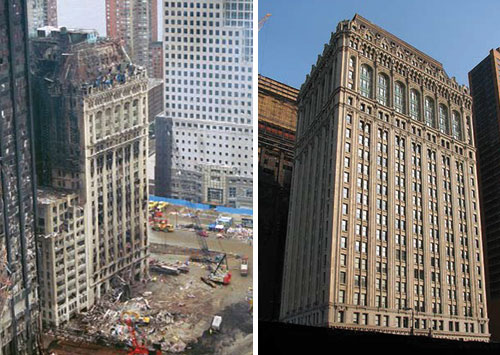Concrete Masonry in Green Buildings
Beyond the traditional reasons to use CMUs, architects and owners seeking to design green and sustainable buildings have begun to discover and realize that all of these inherent attributes of concrete masonry attest to its true long-term sustainability. That is, it holds up well over time providing a very durable and resilient building that is easy to care for and maintain. And in most cases, it offers very positive life-cycle qualities related to cost and environmental impact.
 |
Demonstrating the resilience of CMU, the West Street Building by Cass Gilbert was reopened in 2005 after being damaged by the World Trade Center collapse and a five-day fire in 2001. Photos courtesy of Oldcastle® Architectural |
Green building design is based on a variety of principles particularly related to the products used in construction. CMUs have gained attention in recent years for being very consistent with these green principles including its qualities of:
Use of natural materials. CMUs are manufactured around the world from sand, aggregate, and Portland cement, all of which are common and natural materials.
Low environmental impact. The materials that go into a CMU can be obtained using processes and procedures that respect the environment and restore areas where material is extracted. Further, recycled content is not only possible, but quite common, thus avoiding further extraction.
User comfort. High levels of acoustic, thermal and visual comfort are achievable using CMUs in interior and exterior spaces.
Energy reduction. CMU walls can be readily insulated and in many cases can contribute to additional thermal mass in a building which will reduce temperature swings, lower HVAC usage, and save on energy costs.
Noise transmission control. CMU walls typically achieve favorable sound transmission class (STC) ratings and help separate quiet areas from noisier areas.
These inherent characteristics of CMUs have been described as making them “naturally green” in that they have already been doing for centuries the things that we are paying more attention to in building design today. Most notably, the green building movement in this country has given rise to quantifiable rating systems that seek to establish specific levels of achievement in the creation and performance of green buildings. The best known of these green building rating systems has been developed by the U.S. Green Building Council and known as the LEED® rating system. This is actually a family of ratings that apply to different building situations (e.g. new or existing buildings, core and shell, interiors) and in some cases building types (schools, healthcare, retail, homes, etc.). All of the LEED rating systems have been subject to ongoing changes and updates since their inception, but the basic categories of defining green buildings have remained the same across the different versions over time. With that in mind, we'll look at the contributions that CMU can make in each of these green building categories.









